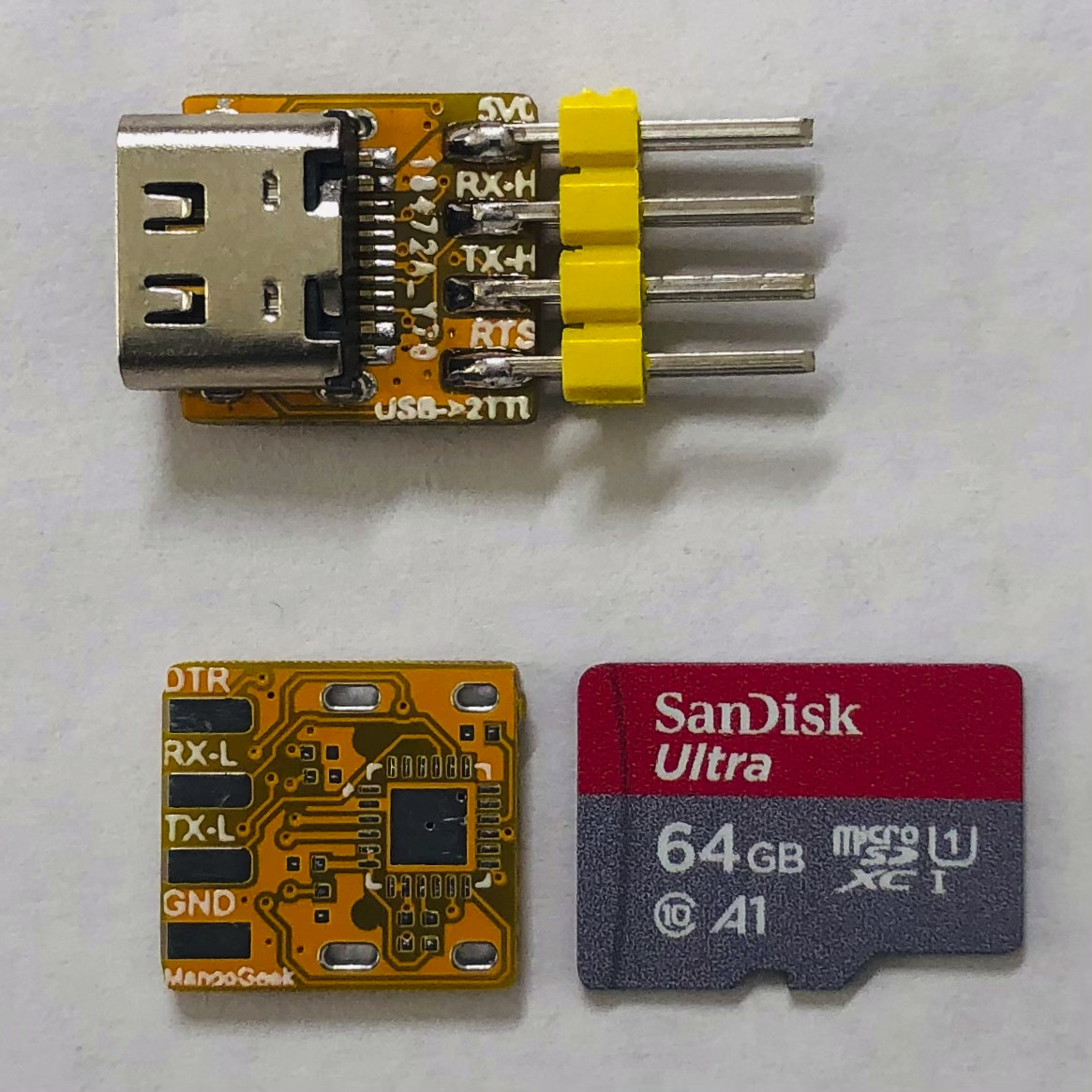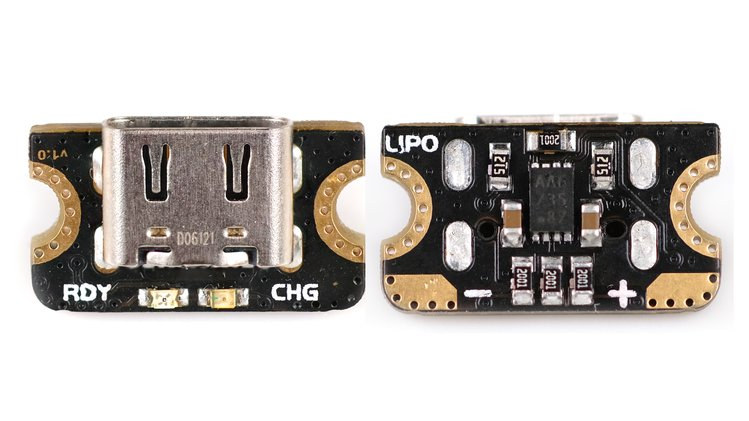The most touted advantages of the USB Type-C port are that it is reversible, enables more reliable and faster charging, and extra features like DisplayPort alt mode. But it’s also about as small as the micro USB port, and yesterday I came across two really small board with a USB-C connector: Ant2 LiPo charger board and a TTL to USB debug board from MangoGeek with two serial ports.
MangoGeek dual serial to USB board
One the dual row header, with eight pins in total, is solder to the board, it’s about as big as a MicroSD card. The board is based on Silicon Labs CP2105 USB to dual UART bridge controller., and provides two Tx/Rx interfaces, DTR, RTS, 5V, and GND signals on the top and bottom of the board.
One of the UART ports could be used to access a Linux serial, and the other to transmit data. The main problem is that it must be very easy to lose…
https://twitter.com/i/status/1356110251016089604
I understand it’s just fresh from the oven and not yet available for sale. I did look for CP2105 on Aliexpress, and there are other similar dual serial USB debug boards, but none of them are quite as small. Size may be important for space-constrained projects, and weight for some battery-operated robots or drones.
Ant2 USB-C LiPo charger board
An even smaller USB-C board, albeit for a completely different use case, is Ant2 LiPo charger board measuring just 16 x 9 x 6 mm.
Ant2 specifications:
- Charge controller – Microchip MCP73831 in DFN package
- USB – USB Type-C port
- Charging current – 500 mA/100 mA
- Charging voltage – 4.20 V
- Status LED – Red – charging; Green – charged
The project is open-source hardware with the CircuitStudio schematics and PCB layout available on Github. If you need the board for your project, Beast Studio has launched it on Crowd Supply for $12 to $13.
The smallest USB-C microcontroller board?
I did not come across USB-C board with MCU yesterday, but in the past, I covered Seeed Studio XIAO board measuring 23.5 x 17.5 mm. It’s over twice the size of the board above, but it’s the smallest USB-C microcontroller board that I know of.

Jean-Luc started CNX Software in 2010 as a part-time endeavor, before quitting his job as a software engineering manager, and starting to write daily news, and reviews full time later in 2011.
Support CNX Software! Donate via cryptocurrencies, become a Patron on Patreon, or purchase goods on Amazon or Aliexpress







It’s a bit confusing when you keep saying “usb-c microcontroller”. It sounds like it’s a microcontroller made for developing usb-c interfaces.
Well you could make a board with just about an attiny and a connector, doing USB in SW
I meant usb-pd, not usb data
Has anyone used the multiport CP210x with linux recently? I built a board with 4 ports with the CP2108 a long time ago and gave up on it because it never worked well with linux.. I remember the ports locking up from time to time.
cp2105 work well in linux
Did I get that correctly 5V and GND are diagonally opposite, so if you twist the connector you fry something?
They are indeed diagonally opposite but I don’t see how you could make them touch together because they’re as far apart as they can be. However if by “twist” you in fact mean connecting it reversed, I agree.
If you mount it 180 degrees from how it’s supposed to be, you’d reverse 5V and GND is what I think they mean. Generally you design connectors so that a 180 degree rotation doesn’t blot the things up–instead +5 would got to TX and GND would go to RX or something relatively safe. Swapping +5 and GND is bad design.
You don’t just randomly assign signals on connectors, you have to put some thought into failure modes–what if it’s in 180 degrees off? What if any two adjacent pins get shorted? That’s why you never put power next to ground–always put a N/C or some signal line between them, etc.
I think whatever you did you always end up with a chance of feeding 5v into 3.3v pins.
Yes so that was my understanding of the comment. I generally agree, but I was confused because I initially thought he meant maybe GND and +5V are very close to each other and could touch if the pins are bent (which would be another design issue). I also thought about mapping them to TX/RX, but usually clamping diodes in the chip on the other side might not necessarily like this joke either.
> Swapping +5 and GND is bad design
I know, just like all those who’ve played with 74LS and CD4000 series and found one particularly hot due to reversal 🙂
LOL, I used to have a 16F88 tatoo on the end of one finger for this reason. Melted the breadboard, too. Since then, I current limit my bench supplies a bit more agressively.
Hehe, in order to avoid frying the Breadbee after soldering the first one, I made this USB current limiter which proved to be very convenient and trivial to replicate: https://github.com/wtarreau/usb-current-limiter
Ahh, I plugged mine into a USB port of a computer with known overcurrent limiting behavior.
Yepp was talking about turning by 180°
But of course with pin headers there will never be a perfect safety unless you restrict yourself to keyed versions (those with the yoghurt cup around the pins)
CP2104 has 4 GPIO lines, I still want to try to add Linux GPIO support for it.
Will try to get a CP2105.
Otherwise CH552E seems to be small too.
Minimal footprint stuff is awesome. Should see the size of my smallest STM32F103 board with can transceiver on board.
Not as small but not bad for UART:
https://fave.co/3pMRZ2i
I bought 100 of those.. The vio is connected to 5v from what I remember so they are useless for anything except stuff like old arduinos running on 5v.
That’s poorly thought out. Using 3.3V out would make much more sense as it’s compatable to 3.3V and 5V devices. As long as the input was 5V tolerant. I was going to suggest doing a little cut and jump to alter them to 3.3V operation, but not on 100 of them!
Yep really poor design. I keep running out of CP2102 modules for all of the junk I have so I thought I’d just buy 100 of those really cheap things and have a lifetime supply that I can permanently attach to things.
Fixing 100 of them isn’t really worth the time and I think I’d end up using a unfixed one instead of a fixed one by mistake… So at some point I’ll probably just get 100 cp2102s off of taobao instead.
Another crowdsupply? 😉